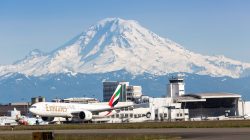Delta continues to expand in Seattle and encroaches on routes that have been long time Alaska Airline strong holds with more domestic flights to and from Seattle. This all began in March of 2012 when Delta announced expansion plans in Los Angeles. Included in that plan were new routes to Seattle, Spokane, Costa Rica, Boston and more. Then in July, Delta announced more west coast expansion from LAX to smaller markets such as Portland and San Jose along with an increase frequency on the Seattle –LAX route, directly targeting Alaska Airline. Today, Delta announced that they would begin service to San Francisco, Las Vegas, and add more flights between LAX and Seattle — a clear attack on Alaska Airlines route network!
The announcement came this morning with the new flights scheduled to begin as early as January 1, 2013. The breakdown of the new service:
- Six new daily nonstop flights from San Francisco beginning March 29, 2014, increasing to seven daily flights on June 5, 2014.
- Two additional flights from Las Vegas for a total of three daily nonstop flights beginning Jan. 6, 2014, increasing to five daily nonstop flights on April 1, 2014.
- Two additional flights from Los Angeles for a total of seven daily nonstop flights beginning June 5, 2014.
Delta’s service from San Francisco and Los Angeles will be operated by Delta Connection carrier Compass Airlines using two-class Embraer E-175s, with the exception of one daily mainline flight from Los Angeles. Additionally, Delta’s Las Vegas-Seattle service will be operated by Delta Connection carrier SkyWest Airlines using two-class Canadair CRJ-700s and CRJ-900s. Each aircraft is equipped with First Class and Economy Comfort seating as well as onboard Wi-Fi.
According to Delta, the expansion is necessary to build upon their increasing number of flights from Seattle to Asia.
‘”San Francisco, Las Vegas and Los Angeles are the three largest West Coast-to-Asia markets in the United States,” said Mike Medeiros, Delta’s vice president – Seattle. “Their addition into this local market will bolster domestic service as well as continue to help support our growing international portfolio in Seattle.”
Yet, I question what Delta is doing because an expansion in Seattle means less dependency on Alaska Airlines to connect passengers to their international flights departing from Seattle. And as we have seen with Delta and their Asian partners, Delta does not play nice when they do not get their way!
I am slightly concerned because Delta is trying to expand in some already crowded markets. The Seattle to San Francisco market is already bursting at its seams with Alaska, Virgin, and United offering 22 daily flights on a mixture of 737s, A320s, and regional jets. San Francisco is Seattles #1 market in terms of traffic and passenger volumn, but can it handle more compition? Especailly the entrace of 450+ additonal daily seats?
Not only is Seattle – San Fran busy, but both Alaska and Southwest both serve the Seattle – Oakland market with a combined total of 10 daily flights on 737s and the Seattle – San Jose Market with 53 weekly flights ( 38/wk by AS and 13/wk by WN). The entrance of Delta’s six daily flights to the Bay area may flood the bay area with new seats and will put pressure on all airlines, especially Delta’s strategic partner Alaska. In addition, the pressure may be just enough to further squeeze cash strap Virgin out of the market.
The LAX to Seattle market is the third busiest route from Seattle, but also an extremely tight market, Delta has already gained some traction in this market, but may be pushing its luck too far. Originally launched with just 3 daily regional flights, Delta up gauged these regional planes to 737s and A320s over the summer as they saw their passenger load volumn grow and Delta added a fourth daily frequency. Before the introduction of service by Delta, Alaska had 75 weekly flights to LAX, which has now been reduced to only 62 weekly flights. In addition, Delta is still codesharing with Alaska on EVERY flight from LAX to Seattle, but Alaska does not put its flight number on Delta operated flights between the two markets! Meanwhile, Virgin has scaled back from 28 weekly flights to 26 and United has reduced operations to 19 weekly flights on regional jets between the two city pairs; originally 21 weekly flights before Delta started operations. Despite the growth by Delta, the Seattle – LAX market, from June 2012 – June 2013, decreased by about 16,000 passengers from then the previous year.
Finally, we come to the Seattle to Vegas market. A market that currently only sees nonstop competition between Alaska and Southwest after US Airways pulled out of the market in 2007. Currently Alaska operates 60 weekly flights between the two cities and Southwest operates 34 flights weekly. The two airlines have dominated this market for the last 5 years; is there room for Delta? Passengers will decide, but according to RITA, Las Vegas is Seattle’s 7th busiest market with over 557,000 people traveling between the two cities each year. But what’s more important is that the Las Vegas – Seattle market, in comparison to the previous year, has seen a decrease in travelers over the last year with 13,000 less people traveling between the two markets during June 2012 – June 2013 time frame.
Delta has seen increased growth on the west coast with a continual focus on Los Angeles and Seattle over the last year. However, as Delta continues to push forward with its plan, it’s going to have to tread lightly with Alaska Air. Alaska Airlines frequent flyers have been noted as the most loyal in the industry and I do not believe that Delta could not maintain its large international presence in Seattle without the passenger feed from Alaska Airline. As I mentioned above, Delta is still code-sharing on all of Alaska flights between Seattle and Los Angeles, but Alaska is not placing its code on Delta’s flight. This is becoming more and more of a one-way relationship between the two airlines, with Delta using Alaska and then spitting them out when they are no longer needed. On the other hand, I could be completely wrong, and Alaska could be using this opportunity to move out of low-cost, low margin markets and move into more dynamic markets and diversify their route network. If Alaska decreases its frequencies on its San Fran, LA, and Vegas routes, we could see more interesting destinations on the ever growing Alaska route map. After all, Alaska has opened a new base in San Diego, and continues to open up new markets in the Midwest and east coast.
No matter what happens, I advise Alaska to be careful with Delta Air Lines. Delta has shown the world that they are ruthless and will turn their back on their partners at any time. Being the world’s second largest airline, Richard Anderson’s (Delta’s CEO) ego has become slightly too large and he has developed what I believe is a “you can’t touch us attitude” . On the flipside, Delta may be shooting themselves in the foot by trying to expand so rapidly in Seattle. United Airlines had a large domestic presence in Seattle in the 80s and 90s and quickly dismantled their route network succumbing to the power of Alaska Airlines. If Delta is not careful, their fate in Seattle may be the same.





